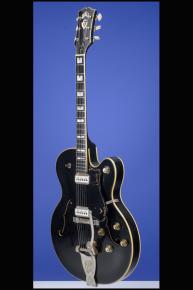A Super Rare Rebel Rouser! - Factory Refinished in (in 1965) Black
This super rare 1963 Duane Eddy 500 Rock'n'Roll Guitar, with a May 1965 factory black re-finish weighs just 7.10 lbs. and has a nice, fat nut width of just under 1 11/16 inches and a scale length of 24 1/2 inches. Semi-hollow mahogany multi-bound body. Three-piece maple/mahogany/maple neck with a wonderful medium-to-thick profile. Ebony fretboard with 20 frets and inlaid pearl block position markers with abalone "V" inserts. The top and back edges have five-ply binding, the f-holes are single-bound, and the headstock and neck are single-bound. "Lip top" headstock with inlaid pearl "Guild" logo and pearl "G-shield" inlay. Black plastic shield-shaped truss-rod cover with "Duane Eddy Model" engraved in gold. Individual floral-engraved nickel Kolb-made tuners with diamond-shaped pearloid buttons. Two "white-top" DeArmond pickups with balanced outputs of 14.30k and 13.95k. Earlier-style rounded transparent acrylic (or Lucite) stairstep pickguard painted black from the back after a gold silk-screened "Star" and "Guild" have been applied. Four controls (two volume, two tone) on lower treble bout plus master volume control on upper treble bout and three-way pickup selector switch on upper bass bout. Guild clear plastic knobs with G-logo on a gold disc. Guild aluminum bridge with pre-set compensating saddle and Guild Bigsby Vibrato tailpiece. Serial number ("23389") on an orange oval label inside the bass f-hole and also impressed into the back of the headstock. All hardware gold-plated. There is some playing wear to the back of the neck, a few small marks on the body, and the usual finish checking, but overall, this guitar is totally original and in excellent plus (8.75) condition. We have carefully examined every area of this guitar under ultraviolet light and can confirm that the finish is factory original (see note below). Housed in the original Guild black hardshell case with burgundy plush lining (8.00).
"Duane Eddy's 'twangy' guitar sound, which he got from a Gretsch Chet Atkins Hollow Body, made him the most popular solo guitarist of the late 1950s. In 1961 he sought his own endorsement deal, and Guild was the first company to show interest. The Duane Eddy model was based on Guild's T-500, a limited-run thinbody version of the Stuart 500 archtop. Eddy specified two features from his Gretsch: Bigsby vibrato and master volume control on the cutaway bout. Examples from 1962 and 1963 have single-coil DeArmond pickups; mini-humbucking pickups appeared in 1964. The DE-500 was last made in 1969 but was reissued in 1983" (George Gruhn and Walter Carter, Electric Guitars and Basses: A Photographic History, p. 235).
"The majority of the models were finished in blonde, though some were available in sunburst and sometimes, with very attractive figured maple back and sides. By the end of 1963, less than 2 years after the model's introduction, the 'new' Anti-Hum pickups replaced the DeArmonds, which is one of the reasons that the original issue is so rare these days…Production totals for the entire period are not available but there are figures available for the period between 1965 and 1969…According to Carlo Greco not more than 50 Duane Eddy 500's were made with DeArmonds" (Hans Moust, The Guild Guitar Book, p. 83).
In January 2006, we were contacted by Hans Moust regarding this guitar and after sending him detailed photographs and the exact details of the label inside the guitar he wrote back to us the following: "Thanks for sending that information. That's exactly what I thought that should be written on the label, because that's how it was listed in the original ledgers of 'final assembly'. If the guitar had been an original 'Black finish' the information would have been on the label and at the same time it would have been written up in the ledgers, which tells me that the guitar has been refinished at a later date. There's also an entry for this guitar in the 'repair ledgers' where it has been written up as being repaired [re-finished] on 5/18/1965 and again it is written up as a DE-500, so it definitely left the factory [in 1963] with an other than a 'Black' finish."
Translate:









